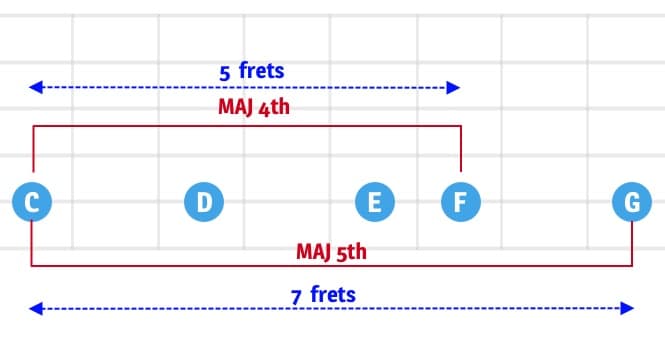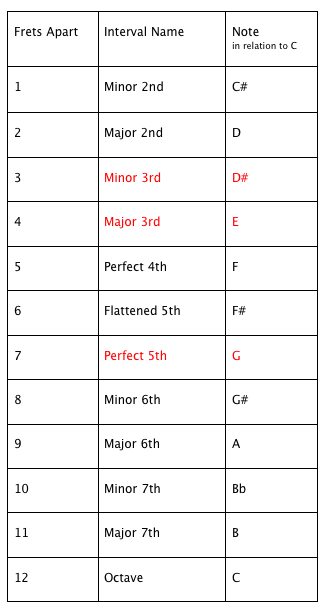
MUSIC THEORY
INTERVALS
Intervals are a key music concept that tell us how far apart two notes are from each other. This knowledge enables us to create chords.

GOAL:
- Understand the concept of intervals
- Learn the intervals between all 12 notes
- Practice identifying the major 3rd, minor 3rd and fifth interval
See the previous articles on Music Theory – strongly recommended to read these first!
Intervals
The next article in this series will explain how we can construct our own chords.
In order to do that, we must start with the concept of intervals.
TIP:
The interval between two notes just tells us how ‘far apart’ they are.
Two houses can be (say) 3 kilometers apart and similarly two notes can be (say) a ‘major third’ apart (an interval we will learn below!
We learned the C Major scale in a previous chapter.
The C Major scale played on the 5th string looked like this.

Because this is a C major scale, we refer to the C note as being the first note or “root” of the scale.
It’s easy to see that D is the second note of this C major scale.
We refer to the distance between C and D as being a major second.
E is the third note of this C major scale.
We refer to the distance between C and E as being a major third.

If you want to think about this ‘distance’ in terms of frets, two notes are
- a major second apart = 2 frets apart.
- a major third apart = 4 frets apart.
TIP:
The reason that 2 frets apart is called a major second is because the distance between the first and second notes of the major scale is 2 frets apart
Fourths and Fifths
If we examine the fourth and fifth note of the major scale (using our example in C Major), we will see that the 4th note of the scale is F and the 5th note of the scale is G.

If you want to think about this ‘distance’ in terms of frets, two notes are
- a fourth apart = 5 frets apart.
- a fifth apart = 7 frets apart.
TIP:
It’s enough to remember 3 things for now:
- the minor 3rd interval is 3 frets higher
- the major 3rd is 4 frets higher
- the fifth is 7 frets higher
Roman Numerals
Chord changes are often described in a roman numeral notation.
- If you see a I-IV chord change in C that just means C is the I (root) chord and F is the IV chord (a fourth above or 5 frets higher).
- If you see a I-Vm chord change in C that just means that C is the I (root chord) and G is the V chord (a fifth above). The Vm would just indicate G minor. So the chord change is C – Gm
- If you see a II-V-I chord change then this would be D (second) then G (fifth) then C (first/root). So a II-V7-I would be D-G7-C
TIP: BLUES CHORDS
The I IV V chords are often use to describe the chords in a blues sequence. In C, this is the root, fourth and fifth chords which you now know to be C, F and G.
All 12 Intervals

So starting with our “root” note, we see the “most important” intervals in red above
- 3 frets higher is a ‘minor third’
- 4 frets higher is a ‘major third’
- 7 frets higher is a ‘major fifth’
TIP:
It’s enough to remember 3 things for now:
- the minor 3rd interval is 3 frets higher
- the major 3rd is 4 frets higher
- the fifth is 7 frets higher
Get the Learn Fingerpicking Book
Register for the newsletter and I will send you this book (105 pages) and a free lesson once a month.
This is the ideal resource for complete beginners who wish to learn guitar.
